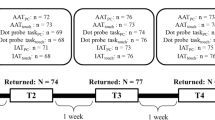Abstract
This paper presents the rationale for a questionnaire measure of individual differences in stimulus screening—namely, individual differences in automatic (i.e., not conceptual or intentional) screening of irrelevant stimuli and rapid habituation to distracting, irrelevant stimuli. The information rate-arousal hypothesis implies that screeners who impose a hierarchy of importance or pattern on the various components of a complex situation thereby reduce its information rate and should be less arousable than nonscreeners. In confirmation of these theoretical notions, the primary component of the questionnaire, low arousability, was directly correlated with the second component, speed of habituation to intense stimuli, and with all other components representing screening in various sense modalities. That is, all components of the questionnaire were intercorrelated and represented a unitary dimension of individual differences in information processing. Also, as predicted, screeners were underrepresented among characteristically aroused persons and among females relative to males. The final 40-item questionnaire, which consists of nine intercorrelated components, is balanced to control for acquiescence and is free of social desirability bias. Applications of the measure in studies of environmental psychology are discussed.
Similar content being viewed by others
References
Berlyne, D. E. Arousal and reinforcement. In D. Levine (Ed.),Nebraska symposium on motivation. Lincoln: University of Nebraska Press, 1967.
Broen, W. E., Jr.Schizophrenia research and theory. New York: Academic Press, 1968.
Chapman, L. J., & Chapman, J. P.Disordered thought in schizophrenia. New York: Appleton-Century-Crofts, 1973.
Crowne, D. P., & Marlowe, D. A new scale of social desirability independent of psychopathology.Journal of Consulting Psychology 1960,24 349–354.
Duffy, E.Activation and behavior. New York: Wiley, 1962.
Dykman, R. A., Reese, W. G., Galbrecht, C. R., & Thomasson, P. J. Psychophysiological reactions to novel stimuli: Measurement, adaptation, and the relationship of psychological and physiological variables in the normal human.Annals of the New York Academy of Sciences 1959,79 43–107.
Eysenck, H. J.The biological basis of personality. Springfield, Ill.: Thomas, 1967.
Eysenck, H. J., & Eysenck, S. B.Manual for the Eysenck Personality Inventory. San Diego: Educational and Industrial Testing Service, 1968.
Gray, J. A. Strength of the nervous system and levels of arousal: A reinterpretation. In J. A. Gray (Ed.),Pavlov's typology. Oxford, Eng.: Pergamon, 1964.
Jackson, D. N.Personality Research Form Manual. Goshen, N.Y.: Research Psychologists Press, 1967.
Kuder, G. F., & Richardson, M. W. The theory of estimation of test reliability.Psychometrika 1937,2 151–160.
Lindsley, D. B. Psychophysiology and motivation. In M. R. Jones (Ed.),Nebraska symposium on motivation. Lincoln: University of Nebraska Press, 1957.
Maltzman, I. Individual differences in “attention”: The orienting reflex. In R. M. Gagne (Ed.),Learning and individual differences. Columbus, Ohio: Merrill, 1967.
Maltzman, I., & Raskin, D. C. Effects of individual differences in the orienting reflex on conditioning and complex processes.Journal of Experimental Research in Personality 1965,1 1–16.
Mehrabian, A.Public places and private spaces: The psychology of work, play, and living environments. New York: Basic Books, 1976.
Mehrabian, A., & Russell, J. A. A measure of arousal seeking tendency.Environment and Behavior 1973,5 315–333.
Mehrabian, A., & Russell, J. A. A verbal measure of information rate for studies in environmental psychology.Environment and Behavior, 1974,6, 233–252. (a)
Mehrabian, A., & Russell, J. A.An approach to environmental psychology. Cambridge: M.I.T. Press, 1974. (b)
Nebylitsyn, V. D.Fundamental properties of the human nervous system. New York: Plenum, 1972.
Nebylitsyn, V. D., & Gray, J. A. (Eds.).Biological bases of individual behavior. New York: Academic Press, 1972.
Pavlov, I. P.Selected works (S. Belsky, Trans.), Moscow: Foreign Languages Publishing House, 1955.
Selye, H.The stress of life. New York: McGraw-Hill, 1956.
Siddle, D. A. T. The orienting response and distraction.Australian Journal of Psychology, 1971,23, 261–265.
Siddle, D. A. T., & Mangan G. L. Arousability and individual differences in resistance to distraction.Journal of Experimental Research in Personality, 1971,5, 295–303.
Sokolov, E. N. Neuronal models and the orienting reflex. In M. A. B. Brazier (Ed.),The central nervous system and behavior. New York: Josiah Macy Jr. Foundation, 1960.
Sokolov, E. N.Perception and the conditioned reflex. New York: Macmillan, 1963.
Thayer, R. E. Measurement of activation through self-report.Psychological Reports, 1967,20, 663–678.
Thayer, R. E. Activation states as assessed by verbal report and four psychophysiological variables.Psychophysiology, 1970,7, 86–94.
Yerkes, R. M., & Dodson, J. D. The relation of strength of stimulus to rapidity of habitformation.Journal of Comparative and Neurological Psychology, 1908,18, 459–482.
Yermolayeva-Tomina, L. B. Concentration of attention and strength of the nervous system. In J. A. Gray (Ed.),Pavlov's typology. Oxford, Eng.: Pergamon, 1964.
Author information
Authors and Affiliations
Additional information
The author is grateful to Leo Collins for his assistance in writing items for Study 1 and keypunching the data obtained in that study. He also wishes to express his thanks to William Fishman and Paula Sapon, who assisted in writing more items for Study 2, helped run that study, and keypunched the data.
Rights and permissions
About this article
Cite this article
Mehrabian, A. A questionnaire measure of individual differences in stimulus screening and associated differences in arousability. J Nonverbal Behav 1, 89–103 (1977). https://doi.org/10.1007/BF01145458
Issue Date:
DOI: https://doi.org/10.1007/BF01145458




